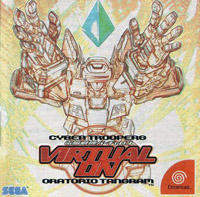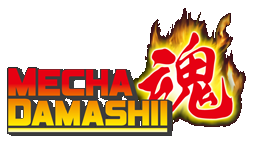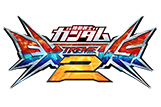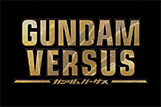Reviews: Virtual On Oratorio Tangram (9/10)
Posted on : 05-09-2011 | By : Cacophanus | In : Reviews
Hardware: Dreamcast
7
 There are few games that can define a console’s gaming worth, that make people go out and buy the hardware just to play that one game. As a series, Virtual On had suffered somewhat in its console renditions. With the first game being seriously hacked apart to make it run on the much less powerful Saturn. Whilst the game was still excellent it wasn’t what the original arcade version was like to play, even with the TwinStick peripheral.
There are few games that can define a console’s gaming worth, that make people go out and buy the hardware just to play that one game. As a series, Virtual On had suffered somewhat in its console renditions. With the first game being seriously hacked apart to make it run on the much less powerful Saturn. Whilst the game was still excellent it wasn’t what the original arcade version was like to play, even with the TwinStick peripheral.
So when SEGA announced that the sequel, Oratorio Tangram, would be ported to the Dreamcast there was a collective sharp intake of breath amongst fans. Could they really pull it off this time? Porting from Model 3 arcade board down to the Dreamcast, wouldn’t that just be as bad as what happened to the first game on the Saturn? More importantly, would it have a new TwinStick peripheral?
All those questions were answered come the game’s release and, for us, this game ultimately ended up defining the console in so many wonderful ways.
Oratorio Tangram, or just Oratan, was originally released as a flagship Model 3 arcade game. Much in the same way the first game had championed the then new Model 2 board, Oratan’s The first two iterations, specifically M.S.B.S. 5.2 and 5.4, used Model 3. It was a graphically impressive game too and quite the step up from what had preceded it.
Oratan was in many ways obviously similar to the first game but it evolved and streamlined much of the core mechanics quite substantially. The same dash based combat was still very much present, as were the distinct usage of ranges. What had changed though was how these core elements worked. Notably the dashing no longer had the same punishing amount of freeze at the end of each manoeuvre, so the tactical element had been sadly simplified in favour of something more reflexive. That said, the dashing functionality did receive a work-over to rectify this.
From Watari dashing, that allowed you to change your direction perpendicularly mid-dash, to the equally new aerial dashing. Whilst the core dashing was tactically simplified the amount of choice in approaches countered that and still offered a new type of tactical variety to the player.
Coupled with this was the updated setup for circle strafing in close combat. Instead of the graded manual control of the first game, the player now had access to a more digital quick step function. Allowing a quicker and simpler entry into the complexities of melee combat. This understandably made close combat encounters faster paced and prone to jump cancels, to avoid melee swipes, but this too had a counter; in the form of a new downward slice to curb cowardly players.
One of the biggest additions though was the new usage of the turbo buttons atop the TwinSticks. Coupled with various trigger inputs, the core weapons for each VR had a form of status modifier applied. Right turbo effectively powered up each shot, whereas left turbo was normally more defensive. Tactical usage of these abilities were also crucial in herding opponents.
So whilst all the manual elements and stringent tactics of the first game had been somewhat eschewed in favour of a more digital but broader menu of attacks, the game hadn’t been ruined as consequence of that. That in itself was and remains quite remarkable.
When the Dreamcast and its specs were finally announced it was clear there would be a disparity though. Admittedly it was nowhere the same kind of gulf that had occurred between the Saturn and the Model 2 original, but it was substantial enough to have fans concerned. In hindsight SEGA did the right thing by ignoring this reaction entirely and keeping very quiet throughout the Dreamcast game’s development.
When the game was finally released at the end of 1999 it was clear that the port was pretty much perfect. Whilst there were graphical discrepancies, notably in the heat haze which was entirely absent in the Dreamcast version, it was nowhere near the amount people were expecting. More importantly though, the game played identically and the TwinStick peripheral offered a refreshingly surgical level of precision to the player’s input.
What really impressed people though was that this port was online, using the console’s modem you could play against other people you’d never even met. Back in 1999 that was a concept that blew a fair few console gamers’ minds. You could even customise the colours of your VR too, something that even the game’s mecha designer Hajime Katoki had done allowing fans to download his colour schemes as well (the latter ended up spawning toys to that effect too).
In short, the port was nigh-on flawless and had in the end catered to the fans’ concerns but simply remedying them head on, rather than trying press based damage control (that seems more and more common in gaming these days).
From the beautifully hand-drawn cover art by Hajime Katoki, to the epically large instruction manual (requiring a special case to house it) an enormous amount of love was poured into this game. Even the TwinSticks were engineered above and beyond what was really required and remain the ultimate peripheral for the Virtual On series to this day.
In some ways, and this is remarkably rare, the Dreamcast port of Oratan was arguably more ground breaking than the arcade version that birthed it. Not only did it showcase the potency and the then unique online nature of its host hardware but it did so almost effortlessly. As games and ports go then this, for us, justified the price of entry.
Tamashii: 9/10
Whilst this review is for the Dreamcast port, the subsequent XBLA version based on M.S.B.S. 5.66 (with online multiplayer) is regarded as highly.











Still occasionally break out my Dreamcast, My Saturn Sticks, and my VOOT. Best console version ever. Saturn Cyber Troopers is good too. I wish Sega would bring this franchise back in a meaningful way.
My brother and I moved our Dreamcast stuff to his apartment but seem to have lost track of this disc! Shame, it was fun to play even though I never figured out how to actually play for a couple of years after buying it when I went back to it on my own.
The jump slash is still one of the most satisfying attacks in any mecha game.
Interesting review.
However, I must correct you on a few points. Tactical elements regarding dash freezes was not simplified. In fact, it became much more complex. Not only were there more ways to initiate an attack, the counters to them also increased.
To put into perspective, VOOM is child’s play to a VOOT veteran. In VOOT, there requires much more future planning and fast thinking (game speed, opponent’s fast offense. Not only did VOOT required more strategy from a player, it also demanded more usage of technique (tsubame gaeshi, double napalm, double daggers) inorder to execute those strategies.
VOOT is a hard game to learn for sure, even for people with years of experience in VOOM or any other game.
That’s what I went on to explain; that the removal of the more stringent and strategical dash freeze bore out other elements that made the game broader. I still think OMG as the better game though, as it’s purer strategy is still very compelling (which is probably why I bought the arcade cabinet for it!).
[…] instance, Hey holds host to a simple Virtual On Oratorio Tangram setup (the 5.66 release) and has a dedicated set of players around it. I owned the cabinet for the […]
[…] in mind that my Dreamcast was pretty much hardwired to play Virtual On Oratorio Tangram from dawn until dusk during those days, so Shenmue was a pretty special game to change my playing […]
[…] the latter, this was simplified in the follow on game Virtual On Oratorio Tangram by having the dash buttons used in close combat to initiate quick steps around an enemy. However, […]